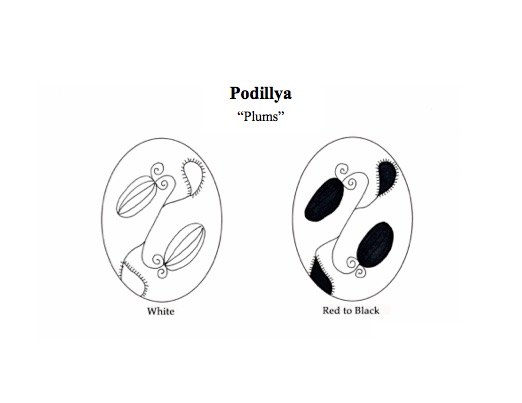Пodillia
Поділля
Пodillia
Поділля

I made this set of traditional pysanka patterns back in the early 2000s. I was going to be teaching traditional pysankarstvo at camp, and wanted a traditional pattern form each region of Ukraine, as there would be kids from many different parts of Ukraine at camp. My sources of traditional designs for these pattern sheets were Onyshchuk’s book and Elyjiw’s Plast stamps.
When looking over one of the plates with traditional patterns from the south of Ukraine, my eye lit upon this “Plum” pysanka: it was striking, the design quite bold, and looked fairly easy to write. I drew up the pattern sheet, and have had many student over the years write this pysanka from Zaporizhia.
Except it wasn’t from Zaporizhia. Nor was it from Odesa region, although it was on the same page as the pysanky from the Odesa region. It is actually an example of Podillian pysanka. How do I know this?
I have found an earlier version of this design in Kulzhynsky, in Table XIV:

Kulzhynskyi gave the provenance of this pysanka as being from the village of Bilousivka (Білоусівка), located in Bratslav povit, Podillia. This pysanka was illustrated in color (above), and came from the collection of Otets Ihnatiy Lototckyi. It was written in 1895, and was called “Slyvky” (Plums).
I am not certain why Onyshchuk decided to change the provenance of this design, as well as the colors. Although the village is now technically in Odesa oblast, it is ethnographically and historically a part of Podillia. The color difference may be simply due to problems with the publication–many of the plates are oddly tinted, and apparently there were later corrections published. This pysanka has bright pink lines as the lightest color in t ebook.
Additionally, she does not discuss the motif except to mention that plums are a beloved Ukrainian fruit, and enjoyed not only as an afternoon snack or made into jam, but also as «сливиця» (slyvytsia), a (presumably alcoholic) drink. And that dried plums are good for digestive ailments.
Selivachov points out that many motifs nowadays given the names of fruit, vegetables and flowers more closely resemble traditional leaf motifs. It may be that in this case, too. The “plums” on this pysanka do not look at all like plums, except maybe in color. It is quite likely that they were floral or leaf motifs that were renamed at some point.

Technical details: This is a fairly simple pysanka, except for the many curves. In this case, though, the curves do not have to be exact, so even a beginner can make a nice version of this pysanka. It has a basic “Lateral” division.
As with most simple traditional designs, a medium or heavy stylus is best for the lines, and of course a heavy one for waxing in.
This pattern utilizes only red and black dyes. For the red, I prefer a deeper color, as opposed to a bright scarlet. A mix of UGS scarlet and red (one pack each) gives a lovely result. To create a more traditional version of this pysanka (a la Kulzhynsky), gold or yellow dye should be used for the first color, and white skipped.
The line width in the example above should probably been a bit heavier. A traditional pysanka such as this, with a simple design, should have heavier (medium) lines.
Download this pattern sheet:
Back to Podillia Home
Back to Western Pysanky Home
Back to Regional Pysanky Home
Back to Traditional Pysanky HOME
Search my site with Google
Plums
Сливки

